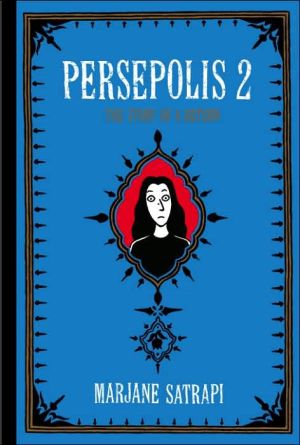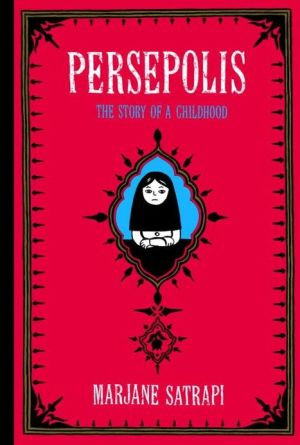Persepolis 2: The Story of a Return
In Persepolis, heralded by the Los Angeles Times as “one of the freshest and most original memoirs of our day,” Marjane Satrapi dazzled us with her heartrending memoir-in-comic-strips about growing up in Iran during the Islamic Revolution. Here is the continuation of her fascinating story. In 1984, Marjane flees fundamentalism and the war with Iraq to begin a new life in Vienna. Once there, she faces the trials of adolescence far from her friends and family, and while she soon carves out a...
Search in google:
In Persepolis, heralded by the Los Angeles Times as “one of the freshest and most original memoirs of our day,” Marjane Satrapi dazzled us with her heartrending memoir-in-comic-strips about growing up in Iran during the Islamic Revolution. Here is the continuation of her fascinating story.In 1984, Marjane flees fundamentalism and the war with Iraq to begin a new life in Vienna. Once there, she faces the trials of adolescence far from her friends and family, and while she soon carves out a place for herself among a group of fellow outsiders, she continues to struggle for a sense of belonging.Finding that she misses her home more than she can stand, Marjane returns to Iran after graduation. Her difficult homecoming forces her to confront the changes both she and her country have undergone in her absence and her shame at what she perceives as her failure in Austria. Marjane allows her past to weigh heavily on her until she finds some like-minded friends, falls in love, and begins studying art at a university. However, the repression and state-sanctioned chauvinism eventually lead her to question whether she can have a future in Iran.As funny and poignant as its predecessor, Persepolis 2 is another clear-eyed and searing condemnation of the human cost of fundamentalism. In its depiction of the struggles of growing up—here compounded by Marjane’s status as an outsider both abroad and at home—it is raw, honest, and incredibly illuminating.The Washington Post - Tara BahrampourRendered in stark, woodcut-like panels, the books captured attention in the United States and Europe partly because they shed light on an era when Iran was too closed to outsiders and too dangerous for Iranians to be depicted with any real depth. Through personal, often painful anecdotes, Satrapi explains how the Westernized country of the shah was transformed so quickly into a surreal world of doublespeak and double lives.
\ From Barnes & NobleIn 2003, Marjane Satrapi's comic-strip memoir, Persepolis, startled and captivated readers with its child's view of Iran's descent into fundamentalism, repression, and violence. This sequel presents the story of Marjane's reluctant return to her homeland after a self-imposed exile in Vienna. Her homecoming forces her to confront changes in both herself and the land of her birth.\ \ \ \ \ Luc SanteSatrapi's voice is as artfully artless as her graphic style, never giving any indication of effort or calculation but simply communicating, in a way that feels unmediated, like a letter from a friend, in this case a wonderful friend: honest, strong-willed, funny, tender, impulsive, self-aware. It's hard saying goodbye at the end, but the end of the story marks the beginning of her ability to tell it.\ — The New York Times\ \ \ Tara BahrampourRendered in stark, woodcut-like panels, the books captured attention in the United States and Europe partly because they shed light on an era when Iran was too closed to outsiders and too dangerous for Iranians to be depicted with any real depth. Through personal, often painful anecdotes, Satrapi explains how the Westernized country of the shah was transformed so quickly into a surreal world of doublespeak and double lives.\ — The Washington Post\ \ \ \ \ Publishers WeeklyPart one of Satrapi's autobiographical graphic novel found her surviving war, the Islamic Revolution, religious oppression and the execution of several close friends. If part two covers less traumatic events, it's also more subtle and, in some ways, more moving. Sent by her liberal, intellectual parents from Tehran to Vienna to get an education and escape the religious police, rebellious but vulnerable teenage Satrapi learns about secular freedom's pitfalls. Struggling in school, falling in with misfits and without a support group, she ends up dealing drugs for a boyfriend and eventually finds herself homeless on the streets. Forced to return to Iran, Satrapi must once again take up the veil, but learns to live within the constraints of her native land, which border on the surreal. For instance, while Satrapi's racing to catch a bus, the religious police tell her to stop running so her bottom doesn't make "obscene" movements. "Well, then, don't look at my ass!" she angrily responds. The book's cornerstone is her relationship with her parents, who seem to have enough faith in her to let her make the wrong decisions, as when she marries an egotistical artist. Satrapi's art is deceptively simple: it's capable of expressing a wide range of emotion and capturing subtle characterization with the bend of a line. Poignant and unflinching, this is a universally insightful coming-of-age story. (Aug.) Copyright 2004 Reed Business Information.\ \ \ \ \ KLIATTThis is the sequel to Persepolis, the highly praised memoir of a girl's childhood in Iran. Persepolis ends when 14-year old Marjane left Iran; Persepolis 2 begins when she arrived in Austria. Unfortunately, Marjane experienced culture shock and found it difficult to fit in. Partying with those crazy young Europeans only made matters worse, as it introduced her to hard drugs. Eventually, Marjane ended up living on the street. She decided to go back to Iran, a totalitarian state where women are denied freedoms as basic as how to dress. There she went to art school, got married, got divorced, and finally left Iran again. If you don't have the hardcover edition of Persepolis 2, by all means purchase the paperback. Although this is the type of graphic novel that librarians will like more than their young charges, I wholeheartedly recommend both Persepolis volumes. The author's b/w art is simple but expressive, focusing on her characters and their emotional states. Satrapi is quite funny, and very honest about her own foibles (she thinks the world should revolve around her). Persepolis 2 contains vulgar language (both the f-bomb and the s-bomb) and adult situations, so you may want to think twice before giving this to younger patrons. KLIATT Codes: SA*—Exceptional book, recommended for senior high school students, advanced students, and adults. 2003, Random House, Pantheon, 187p. illus., Ages 15 to adult. \ —George Galuschak\ \ \ \ \ Library JournalSatrapi's first Persepolis book, chronicling her life as a child in Iran during the Islamic Revolution and the war with Iraq, was one of the best and most widely praised graphic novels of 2003. This second volume picks up the story as she arrives in Vienna to attend high school and recounts her difficult, though not friendless, assimilation into a far more liberal culture. She's stung by prejudice and shocked when her friends first engage in casual sex. When she returns to her homeland, she faces another culture shock, as her now-entrenched free-thinking attitude makes acceptance of everyday repression even tougher. Feeling like a woman without a country, she must decide where her future lies. As with the first volume, Satrapi's simple drawings are very effective, and the story is laced with humor and surprising instances of Western infiltration of Eastern culture. Satrapi movingly portrays the love and wisdom of her parents, who are determined to let her live her own life, and of her grandmother, who reproaches her when she strays too far. Like the first volume, this remarkable memoir is highly recommended for older teens and adults. [See Prepub Alert, LJ 4/15/04.] Copyright 2004 Reed Business Information.\ \ \ \ \ School Library JournalAdult/High School-In Persepolis: The Story of a Childhood (Pantheon, 2003), Satrapi vividly described her early life in Iran. This second installment covers the period after the 1979 Revolution when, at 14, she was sent to Vienna for a freer education than that allowed in her newly fundamentalist country. At first, the distinct differences in her life were overwhelming and exciting. During the next four years, she made new friends, some very liberal and some quite conservative, had several relationships, became increasingly aware of the sexual freedom of her new milieu, and even dealt drugs for a boyfriend. Eventually, she ended up living on the streets. She became ill and returned home, a somewhat liberated 18-year-old in a repressive land. She married, mistakenly thinking that would allow her freedom, and graduated from art school. At the end of this volume, feeling out of place in her homeland and unhappy in her marriage, she has divorced and is preparing to move to France with the blessing of her understanding parents. (A third volume is soon to be translated.) Satrapi's simple-seeming, black-and-white drawings add a surprisingly expressive depth to her already compelling story. Teens will appreciate this memoir on many levels, identifying with the feelings of alienation and misunderstanding, if not the actual events. Young people who have had to flee to new environments will identify even more.-Susan H. Woodcock, Fairfax County Public Library, Chantilly, VA Copyright 2004 Reed Business Information.\ \








